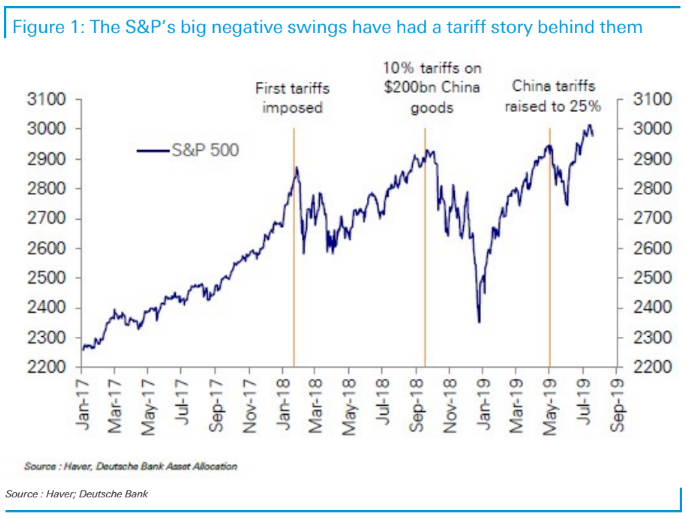Maybe investors got a little too relaxed about the U.S.-China trade war. After the stock market’s worst week of 2019, that’s not the case any more.
And if history is a guide, they should probably remain on their toes, analysts said.
“I think the U.S. market, having been recently at record highs, does indicate that there has been some complacency” in the face of a clear global economic slowdown, said Marina Severinosky, investment strategist at Schroders, which has $536.7 billion in assets under management, in an interview.
The dose of reality came via President Donald Trump’s Twitter account, which he used early Thursday afternoon to announce a plan to impose 10% tariffs on an additional $300 billion of imports from China beginning Sept. 1. The missive saw stocks, which were getting back on their feet after disappointment in an insufficiently post-rate-cut performance by Federal Reserve Chairman Jerome Powell a day earlier, turn south, with the Dow Jones Industrial Average suffering a nearly 600-point swing from its session high.
Trade-sensitive sectors took it hard. Retailers, in particular, suffered because the additional tariffs would apply to consumer goods that had been spared in earlier rounds of levies. Consumer-discretionary stocks were the worst-performing of the S&P 500’s 11 sectors in the past week, falling 4.6%, with the tech sector not far behind with a 4.4% decline.
See: New Trump tariffs threaten U.S. consumer, spelling wider trouble for stocks, analysts say
The S&P 500 SPX, -0.73% and Nasdaq Composite COMP, -1.32% fell every day of the past week to notch a five-day losing streak, while the Dow Jones Industrial Average DJIA, -0.37% extended its losing streak to four sessions with Friday’s decline. For the week, the S&P 500 fell 3.1%, while the Nasdaq declined 3.9% — the biggest weekly fall for both gauges since December — while the Dow’s 2.6% drop was the largest since the end of May. All three gauges had hit all-time highs last month.
Meanwhile, the broader reaction in commodity and financial markets also underlined how the tariff threat brought home longstanding worries about the global growth outlook. That was illustrated by a nearly 8% plunge for the U.S. crude oil benchmark Thursday blamed on fears over the prospect for global oil demand.
Read: Why Trump’s tariff tweet sparked market mayhem
That was perhaps topped by the plunge in the 10-year Treasury yield TMUBMUSD10Y, -2.60% — and the flattening of the yield curve. The 10-year yield plunged through 2% and ended the week below 1.90%, a level last seen in November 2016. Yields fall as debt prices rise.
“Most of this decline in interest rates has been due to a plunging real yield,” said Joseph LaVorgna, chief economist, Americas, at Natixis, in a note, referring to the nominal yield minus inflation.
“This means investors are becoming more downbeat on U.S. growth prospects. If U.S. inflation expectations fall, the current rally [in Treasury prices] would likely persist,” he said. “This is why we expect the Fed to continue to reduce interest rates, both in an attempt to lift growth and inflation expectations.”
Indeed, expectations around the Fed were whipsawed amid suspicions that Trump’s decision to intensify the trade skirmish was aimed largely or in part at getting the Fed to deliver the aggressive easing that Powell shied away from Wednesday when he described the central bank’s first rate cut in more than a decade as a “mid-cycle adjustment” and not the start of a “lengthy” cycle of cuts.
See: September rate cut ‘fully priced,’ with Trump tariff tweets seen pushing the Fed to take more action
Meanwhile, investors will be watching China. While China’s yuan weakened to trade near the 7.0 level versus the dollar, most analysts expect Beijing to resist the temptation to significantly devalue the currency, with the focus likely instead to center on additional fiscal and monetary stimulus.
That reluctance stems partly out of fear that letting the yuan slide would destabilize domestic markets, said Alan Ruskin, chief international strategist at Deutsche Bank, in a note.
Meanwhile, he warned against “fading” global equity market weakness, noting that “tariff-related risk-off events tend to be multiweek and usually have considerable run in them.”
In that regard, he expects “the leading edge of global instability will emanate out of equities,” noting that most of the major equity pullbacks since early 2018 have followed negative developments on the trade front (see chart below).
 Deutsche Bank
Deutsche Bank
Schroder’s Severinovsky said the U.S. market may be due for a correction. That doesn’t mean investors should dump U.S. equities, but “if folks are very overweight to the U.S. [they should] be mindful that the U.S. is not going to be divorced from global markets.”
“It’s not about selling U.S. exposure, it’s that people have become very overweight” U.S. stocks in large part due to the market’s outperformance, she said. Rebalancing efforts should focus on companies that have pricing power and that have avoided becoming overleveraged.
The week ahead, meanwhile, features a relatively light economic calendar. Among the highlights: the ISM July nonmanufacturing index is due Monday at 10 a.m., while weekly jobless claims come Thursday at 8:30 a.m. Eastern and the July producer-price index is set for Friday at 8:30 a.m. Eastern.
Earnings season, meanwhile, enters its latter stage. Through Friday, 77% of S&P 500 companies had reported second-quarter results.
The blended earnings decline, which combines actual results for companies that have reported and estimated results for companies that have yet to report, for the second quarter stands at -1%, up from -2.7% last week, according to FactSet. If -1% is the actual decline for the quarter, it will mark the first time the index has reported two straight quarters of year-over-year declines in earnings since the first and second quarters of 2016, meeting the definition of an “earnings recession.”





